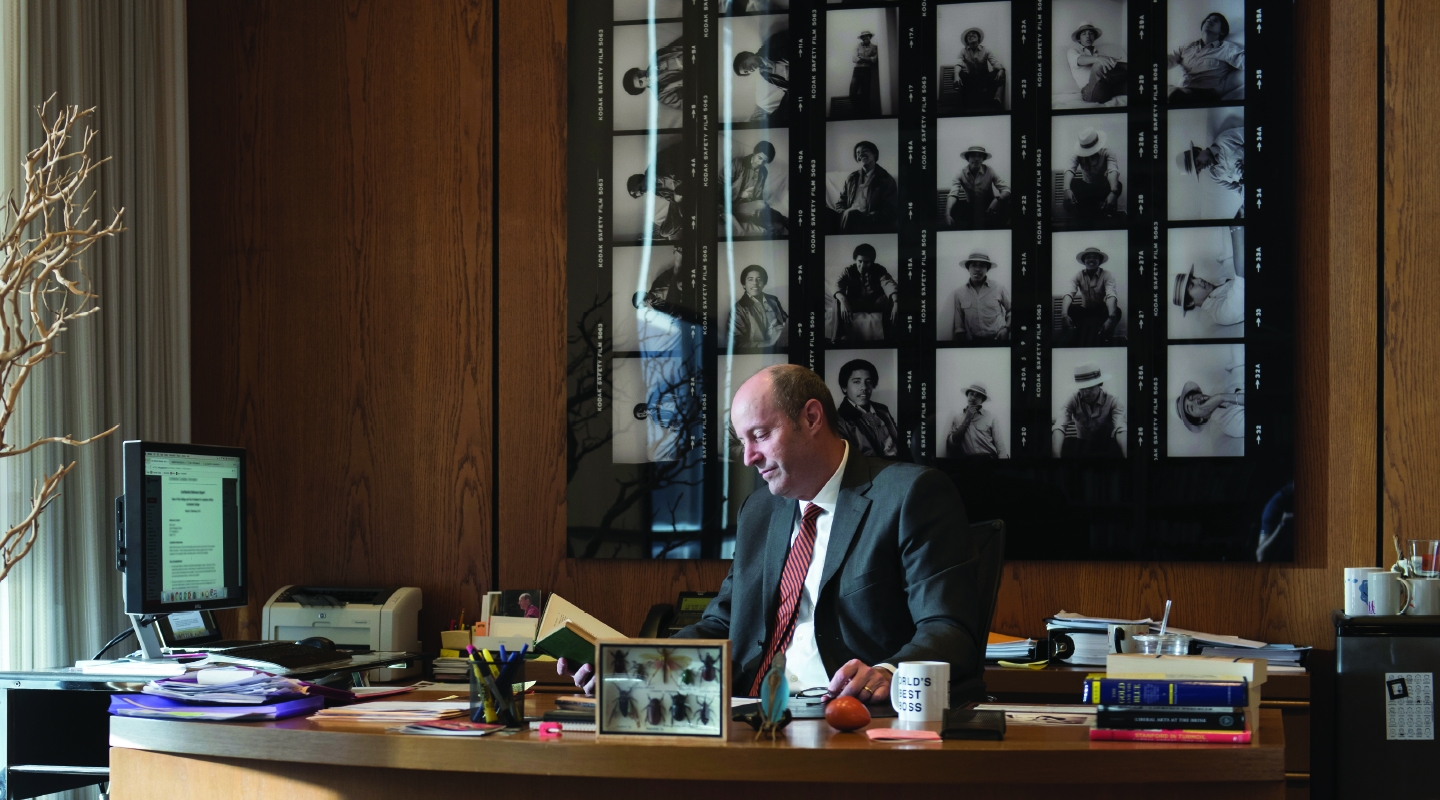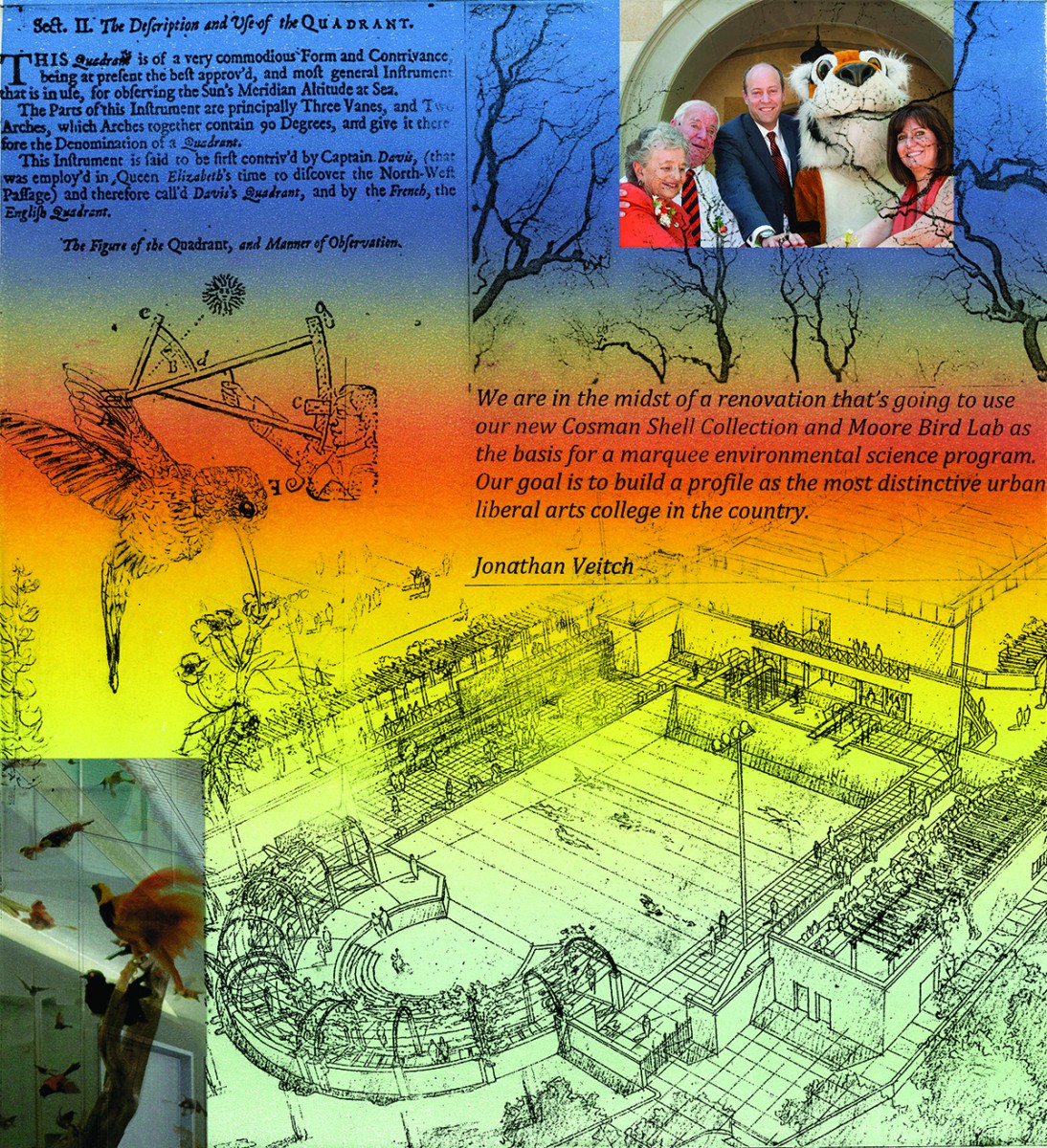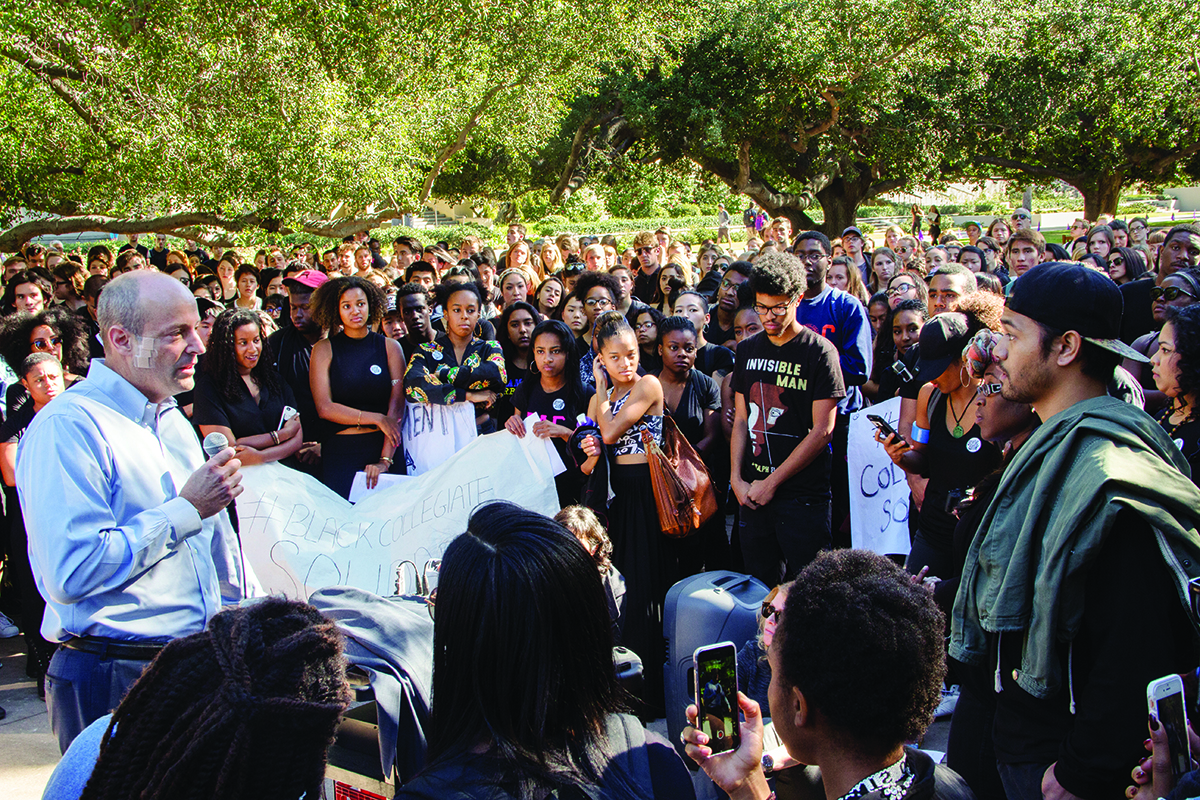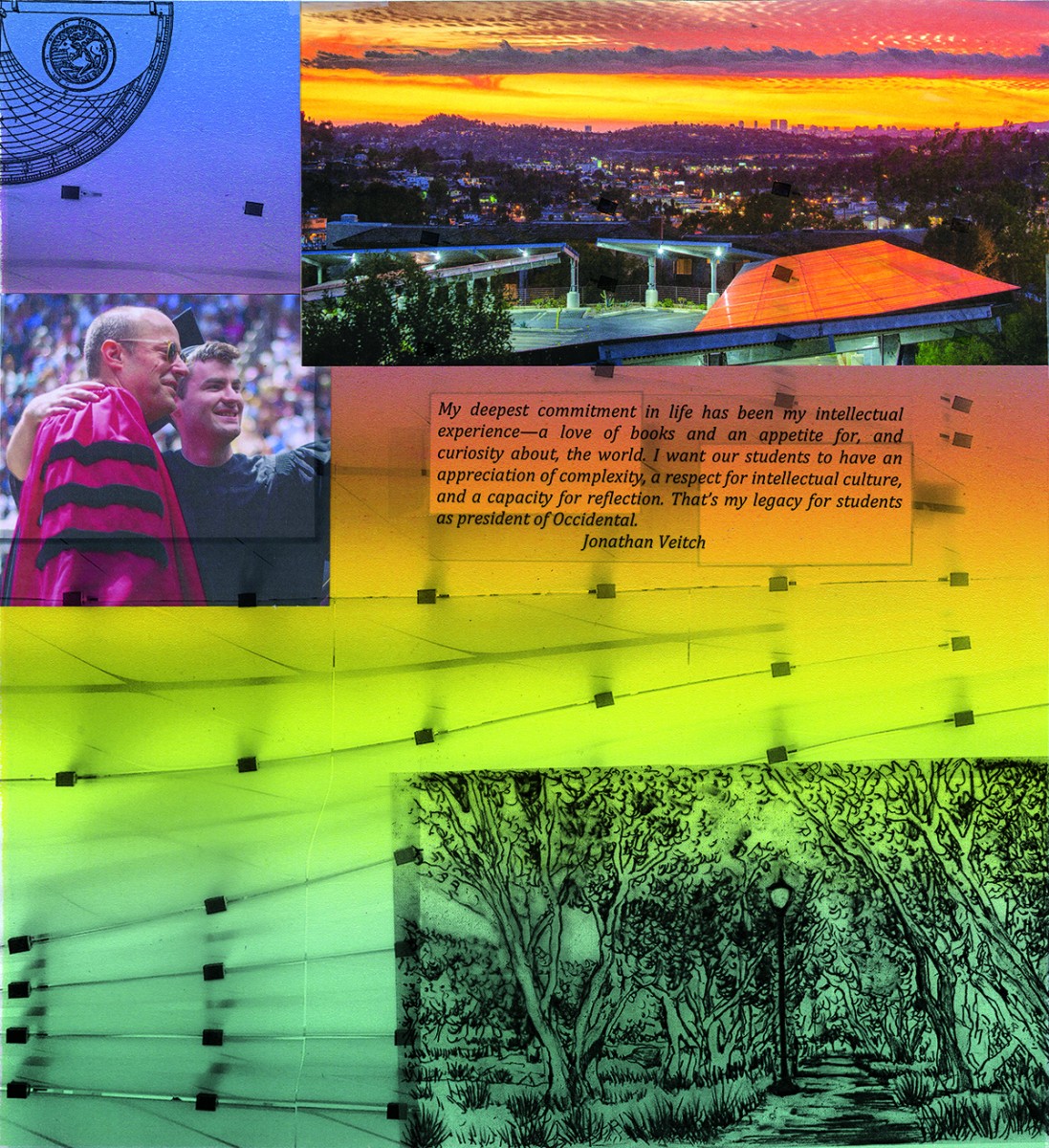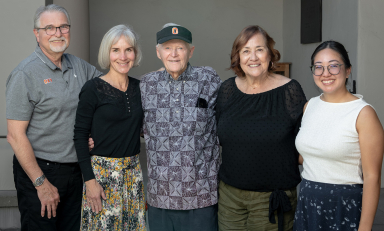With Jonathan Veitch announcing his plans to step down next year, trustees, alumni, and colleagues discuss his impact on the College over the last decade.
Early in his career, Jonathan Veitch recalls sitting in on a presidential search at a liberal arts college where he was a visiting professor. The finalists were making their pitch for the job and Veitch was listening closely. “Even then, I must have been thinking about becoming a president and didn’t realize it,” he says. “The faculty would ask them questions, and their answers were kind of in the weeds—and not terribly thoughtful. They didn’t illuminate the intellectual stakes involved. That’s so important for somebody who aspires to lead an institution. They have to have some sense of why even the most incremental decision matters.”
It’s never been easy to be a college president. William McRaven, who stepped down last year after four years as chancellor of the University of Texas, remarked that leading an academic institution is “the toughest job in the nation”—this coming from a former Navy admiral who planned the raid that killed Osama bin Laden.
While Veitch had nothing to do with that particular mission, he knows a thing or two about McRaven’s other vocation. “One of the things I love most about being a college president is that no two days are alike,” Veitch says. “The morning often starts with some fire to put out. Then there’s a fundraising call; a meeting with faculty to work through some complicated issue; and a review of the blueprints for a new construction project. That’s all before lunch—which, if I’m lucky, is with some of our students. Every muscle is working. This job stretches you—and if you do it well, it makes a difference.”
On June 30, 2020, after 4,018 days on the job, Veitch will step down as Occidental’s 15th president. In an era where the average tenure of a college president has shrunk to 6.5 years, his 11-year tenure is atypical. When Veitch walked into his office for the first time in July 2009, he became the College’s fifth president in five years—a period of administrative instability that had taken an inevitable toll.
“When I arrived 10 years ago, the most important task for an incoming president was to reestablish confidence and a sense of forward momentum,” Veitch observes. “After a significant degree of turnover in the president’s office, there was considerable skepticism about the institution and its capacity to move forward.”
“Jonathan came into as bad a situation as you come into from a managerial point of view,” says Stephen Hinchliffe ’55, Board of Trustees chair emeritus and one of the president’s biggest admirers. “He has done a remarkable job of turning that around—and in the face of a variety of challenging social issues that have added a whole new dimension to being a college president.”
“Stories that begin with a line like ‘It all started in a hotel lobby in New Jersey’ usually don’t end well,” Veitch says with a laugh. “But that’s where my association with Oxy began.” In November 2008, Veitch sat down with trustees John Farmer and Dennis Collins over lunch in a hotel adjacent to Newark Liberty International Airport to discuss the job opening at Oxy. Barack Obama ’83 had just won a historic election as the nation’s 44th president, and his ascendancy to the White House raised the profile of the College—his application photo to Occidental graced the cover of Newsweek in March 2008—and gave a bump to applications for admission that continues to this day.
It couldn’t have come at a better time. By 2005, under President Ted Mitchell, Oxy had rebounded from years of budget deficits. But Mitchell’s sudden departure that year put the brakes on plans for a comprehensive campaign that many hoped would get the College moving again. In addition to the turnover in presidential leadership, Veitch’s arrival in 2009 came at the nadir of the financial crisis and growing unease among alumni about Occidental’s direction.
Veitch—who had recently completed a run as dean of the undergraduate division of The New School in New York City—was alerted to the Occidental opening by his former boss. “To be honest, Oxy was the very first presidential job that I applied for and I didn’t expect to get it,” he says. “I was thinking that this would be a great way to road test my interview skills. When I got invited to Los Angeles for a second round of interviews, I thought, ‘Uh-oh—I’d better tell my wife.’”
Of all the serious contenders to be Oxy’s 15th president, Veitch was the only one who applied, unsolicited, for the job. (“I wanted it, and I wasn’t afraid to come out and say so,” he recalls.) “In his application letter, Jonathan talked about the power of liberal arts, the fact that Occidental is in one of the most interesting cities of the world, the potential to connect with other world-class institutions in the city, and the importance of diversity,” says Collins, who chaired the Board from 2006 to 2009 and also worked alongside Veitch as senior vice president for institutional advancement and external relations at the outset of his presidency. “These were all issues the Board had talked about—he had done his homework.”
“Jonathan had all of the leadership responsibilities that are consistent with the president of a small liberal arts college,” Farmer (who succeeded Collins as Board chair) said in 2009. “His experience and his appreciation of a college of liberal arts and sciences were crucial in our deciding that he was the best choice.”
One of Occidental’s most cherished traditions—introduced by Oxy’s 10th president, Richard C. Gilman—involves a meeting with the president and the first-year class during matriculation. “At that introductory meeting, I asked students why they chose Occidental,” Veitch recalls. “Most of the answers centered on the weather, our small size, or our location. But their responses seldom went further than that. There was very little specificity about the quality of the academic experience or the programs that defined that experience.” The problem he saw at Oxy was that the College had lived under straitened circumstances for so long “that it had lost the ability to imagine a more robust future,” he says. “I don’t think people realize just how enormous Occidental’s potential is.”
“Jonathan pushed us to develop and implement a strategic plan,” says Amy Lyford, professor of art and art history and former associate dean. “He did a plan, made things happen, made strategic hires. We may struggle to implement the plan as well as we would like, but the idea of Oxy in L.A. is the essential legacy he’ll leave behind. You can disagree over how the priorities were arrived at, but it’s the first time since I’ve been here that we’ve had a strategic plan.” (She joined the College in 1999.)
“When we were doing the strategic plan [from 2010 to 2012], I realized that we had all these underappreciated assets around us,” Veitch says. “We weren’t really taking advantage of our urban location and stitching Oxy into the fabric of the city.”
“It was a case of new eyes—someone who grew up in Los Angeles and could come back and see it differently than those of us who had been working close in,” says Chris Calkins ’67, who chaired the Board of Trustees from 2013 to 2016. “He was constantly looking for those things uniquely available to a liberal arts college in L.A. It was also apparent in the way in which he set his own objectives that he believed in the liberal arts and that there was a place for Oxy to lead.”
“The first step in taking advantage of our location was to get our students out into the city, and encourage them to treat their environs as an open-air laboratory,” Veitch says. “On our doorstep the world’s problems and opportunities are being played out on a daily basis. This presents our students and faculty with an unparalleled opportunity to shuttle between the classroom and the field in pursuit of a better understanding of issues like the persistence of poverty, homelessness, and architecture and urban planning.” On his watch, the College supplemented this focus on Los Angeles by fostering partnerships with major cultural institutions, enhancing civic engagement opportunities for students, hiring faculty with expertise in urban issues to teach across the curriculum, and creating a new Institute for the Study of Los Angeles.
“Jonathan was driving hard during the first years of his presidency,” Calkins says. And he got results. “Academic culture often emphasizes process over outcomes,” Veitch says. “I have a difficult time doing things that way, and I’ve been criticized for it. If I can see the finish line, I want to get there as quickly as possible.”
As for the first-year students Veitch meets during matriculation? “They no longer tell me that they come here for the weather—or at least, that’s not the first thing they tell me.”
Despite this strong start, Veitch hit some choppy waters during the middle of his presidency. There were concerns among some students and faculty about sexual misconduct on campus, which led to a complaint to the U.S. Department of Education’s Office of Civil Rights. The ensuing investigation lasted almost four years. “We were eventually exonerated but it was hard to live under that cloud for such a long time without any resolution,” Veitch says.
That wasn’t the only flare-up to cross his desk. Student discontent over the lived experience of race precipitated the largest protest in recent memory, the five-day occupation of the Arthur G. Coons Administrative Center in November 2015. During the third night of the occupation, as trustees and staff members worked inside Samuelson Alumni Center well into the evening, the building was surrounded by several hundred students and their allies, who closed ranks into a circle and barred the building’s occupants from leaving. After firefighters cleared a path for their exit, Jonathan and Sarah Veitch exited the building to taunts from the protesters.“I don’t dwell too much on those unhappy moments, though I’ve tried my best to learn from them,” Veitch says. Recalling that evening at Samuelson, he observes, “It was tough. One member of our staff became hysterical when she couldn’t get out of the building. I don’t remember why Sarah was there, but I do remember thinking that I didn’t want her to see the College at its worst. I was afraid she would lose faith in the institution.”
“After the occupation, I was sure that Jonathan was going to call it quits any day,” says Ella Turenne, associate dean of students. But Veitch stood up in front of his critics less than two weeks after the occupation ended, taking tough questions from a packed Choi Auditorium during a community meeting on Dec. 3, 2015.
“One of the challenges of my office is that it is all-consuming and it requires a great deal of time away from the campus,” Veitch told the crowd. “I focused on raising money for this institution at the cost of being present to the people in this room. And I own that.”
In the months that followed, Turenne recalls, “Some students commented that no matter how much they pushed at him, they felt he listened to them, wanted to hear what they had to say, and continued to come back to the table. Even with all the controversies that have happened, I hope that people can see that his actions reflect his commitment to the College.”
“The chief call for a college president is emotional intelligence, because on any given day there are a dozen reasons to get discouraged,” Veitch says. “If you let yourself respond to the multiple provocations that are offered up by critics, you can easily become an unhappy person, not to mention a difficult person to work with. There is so much joy in what we do, but it is easy to forget that when things become hard.”
“I’m telling you, it’s a hard job,” says Kerry Thompson, associate professor of biology and former interim dean of the College. “When Jonathan invited me to his office to tell me he was stepping down, I wanted to tell him face-to-face that I thought he was courageous in the way he persisted under sometimes embattled conditions. I’m not saying every position he took was right, but he was well-intended all the way through—thoughtful and high-minded.”
More than ever, Veitch remains committed to the fundamentals of a liberal arts education, and feels strongly that it is the best preparation for a successful career. “Among other things, it gives students the ability to take a complex idea, break it down into its component parts, gather evidence, negotiate positions with which they disagree, and then make their case in a compelling written or oral form,” he says. “Those are the skills of a successful manager in any field of endeavor, and those skills matter enormously in a knowledge-based economy. And if that’s not reason enough, a liberal arts education also imbues students with the capacity to reflect on the value of a life well-lived.”
When he steps away from his desk in June 2020, it will be 11 years—tying him with John Brooks Slaughter for fourth place in presidential longevity. “There are many reasons why I thought it was the right time, but the most relevant one is quite simple: I believe that we have achieved most of what I set out to accomplish. We’ve laid a solid foundation, reestablished momentum, and instilled a new sense of confidence in Occidental’s potential. I’m proud of that. But I think it is time to hand over the reins. It is up to the next president to figure out how he or she wants to build on that foundation.
“People think that a small institution must be relatively simple by nature,” he continues. “But it’s actually a complex ecosystem—and any good president has to recognize the complexities of that ecosystem. You don’t have the luxury of focusing on one or two things—you have to spin 15 different plates with some notion of not just keeping them going but also what the endgame is.”
Veitch has a lot of plates spinning in his remaining months in office: the public launch of a $225-million comprehensive campaign in May, the enrollment of a new class of Obama Scholars, the opening of the Oxy Arts Center on York Boulevard, the dedication of the newly expanded McKinnon Family Tennis Center and Robinson Terrace, and the completion of the De Mandel Aquatic Center that was an unrealized component of the 1992-97 capital campaign. Just over the horizon is the Anderson Center for Environmental Sciences.
After he steps down from the presidency, Veitch plans to return to the classroom as a professor at Occidental following a sabbatical. “I got into the profession because I wanted to read and write and teach. I became an administrator by happy accident. It was a long, circuitous route, but it has been a rewarding one. I miss my books. And as a professor I look forward to seeing what Occidental looks like from the other end of the telescope.”
While doing so, Veitch plans to immerse himself in writing “a reflection on the history, tradition, and value of the liberal arts, with special attention to their importance as a compass for democracy.” And he may just finish the book he started on his last sabbatical: Colossus in Ruins, an examination of how maritime New England, the industrial Rust Belt, and other once-important American sites are memorializing their history. “I want to take the next few years to see whether or not I still have the muscles to do the kind of rigorous academic work I envision for myself, or whether I miss the adrenaline rush of the M*A*S*H unit,” he says. “It’s addictive.”
Knowing what he knows now, would he have been as eager to take on the job as Oxy’s president? “It’s funny—I like to go on long bike trips but I don’t always plan them as well as I should,” he admits. “Sometimes, when the riding is good, I go out much farther than I had intended. When I do, I often don’t get back home until after dark, exhausted and a little sore. Yet those are the best bike trips I’ve ever had.
“Being president is a bit like that. When I arrived at Oxy, I thought I had a road map and enough water for the ride. But I got lost a few times along the way and had a flat tire or two. Even so, it turned out to be a much better trip than the one I imagined. I wouldn’t trade the experience for anything.”

